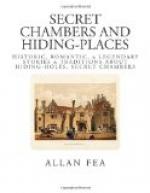After a day spent up in the branches of the famous Royal Oak, the fugitive monarch made his resting-place the secret chamber behind the wainscoting of what is called “the Squire’s Bedroom.” There is another hiding-place, however, hard by in a garret which may have been the one selected. The latter lies beneath the floor of this garret, or “Popish chapel,” as it was once termed. At the top of a flight of steps leading to it is a small trap-door, and when this is removed a step-ladder may be seen leading down into the recess.[1] The other place behind the wainscot is situated in a chimney stack and is more roomy in its proportions. Here again is an inner hiding-place, entered through a trap-door in the floor, with a narrow staircase leading to an exit in the basement. So much for Boscobel.
[Footnote 1: The hiding-place in the garret measures about 5 feet 2 inches in depth by 3-1/2 or 4-1/2 feet in width.]
Moseley Hall is thus referred to by the King: “I... sent Penderell’s brother to Mr. Pitchcroft’s [Whitgreaves] to know whether my Lord Wilmot was there or no, and had word brought me by him at night that my lord was there, that there was a very secure hiding-hole in Mr. Pitchcroft’s house, and that he desired me to come thither to him.”
It was while at Moseley the King had a very narrow escape. A search-party arrived on the scene and demanded admittance. Charles’s host himself gives the account of this adventure: “In the afternoon [the King] reposing himself on his bed in the parlour chamber and inclineing to sleep, as I was watching at the window, one of the neighbours I saw come running in, who told the maid soldiers were comeing to search, who thereupon presentlie came running to the staires head, and cried, ‘Soldiers, soldiers are coming,’ which his majestie hearing presentlie started out of his bedd and run to his privacie, where I secured him the best I could, and then leaving him, went forth into the street to meet the soldiers who were comeing to search, who as soon as they saw and knew who I was were readie to pull mee to pieces, and take me away with them, saying I was come from the Worcester fight; but after much dispute with them, and by the neighbours being informed of their false information that I was not there, being very ill a great while, they let mee goe; but till I saw them clearly all gone forth of the town I returned not; but as soon as they were, I returned to release him and did acquaint him with my stay, which hee thought long, and then hee began to bee very chearful again.
In the interim, whilst I was disputing with the soldiers, one of them called Southall came in the ffould and asked a smith, as hee was shooing horses there, if he could tell where the King was, and he should have “a thousand pounds for his payns....” This Southall was a great priest-catcher.
[Illustration: “PRIEST’S HOLE,” MOSELEY HALL, STAFFORDSHIRE]




